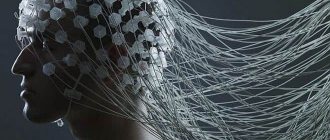Instrumental research methods make it possible to broadly and completely study the state of the brain, the functioning of its cells and parts, as well as diagnose disorders of other organs. How does an EEG differ from an Echo-EG is a question that is asked by almost everyone who has encountered certain disorders of the central nervous system in their life.
EEG and Echo-EG are reliable and safe methods for diagnosing central nervous system disorders. Thanks to both studies, reliable information about the state of the brain can be obtained in the shortest possible time.
Advantages of echoencephalography of the brain in CELT
We employ specialists with many years of experience, allowing them to carry out diagnostic studies as accurately as possible and obtain all the necessary data. They have modern equipment in their arsenal that allows them to get a complete picture. Thus, Echo-EG of the head in our clinic allows:
- identify neoplasms in the early stages of their development;
- conduct a qualitative study of the midline structures and periosteal space;
- determine ICP indicators and the nature of pulsations;
- minimize the human factor and increase diagnostic accuracy.
You can find out the price of Echo-EG in our clinic in the corresponding section of our website or by calling us!
Echo-EG
The echoencephalography (Echo-EG) method involves ultrasound exposure on brain structures. The study is based on the fact that the skin, head muscles, skull bones, and membranes of the brain reflect ultrasound differently. This allows the Echo-EG method to be used for diagnostic purposes.
Using an echoencephalogram, abscesses, hemorrhages, tumors, edema, hydrocephalus, and signs of intracranial hypertension can be diagnosed.
During echo-EG, the patient is usually in a supine position, but it is also possible to sit. The study is carried out by applying an ultrasound sensor to various points on the head. Both its surface and the sensor are treated with petroleum jelly for better acoustic contact. The results are displayed on the computer screen. An echoencephalogram is a diagram of ultrasound signals converted into electrical impulses.
Indications for ultrasound echoencephalography
The study is carried out as part of primary neurological diagnosis when the patient complains of:
- headache;
- constant feeling of nausea;
- frequent loss of consciousness;
- feeling of pressure on the eyes;
- incessant noise in the head;
- disturbances in concentration and memory.
The indication for this is an increase in ICP or the need to measure it, suspicion of the presence of neoplasms, foreign objects, cysts and hematomas in the cranial cavity if computed tomography and magnetic resonance imaging are not available. The study is carried out if necessary:
- confirm the presence of diseases such as epilepsy, brain damage of a degenerative, vascular or inflammatory nature;
- identify the patient’s simulation of hearing and visual impairments;
- assess the brain functioning of comatose patients;
- determine the cause of sleep disturbances and abnormal surges in blood pressure;
- determine the efficiency of functioning of blood vessels and tissues.
Contraindications to echoencephalography in M-mode
Echoencephalography of the brain in children and adults is a safe procedure. It does not require the use of painkillers (or any other pharmacological drugs) and has no physiological contraindications. However, it should be postponed during acute respiratory diseases accompanied by a runny nose and/or cough. It is not used if the patient has open wounds or suffers from psychological disorders in the areas where the sensors need to be installed. The latter can cause hysterics due to the unfamiliarity of the situation.
EEG
EEG – helps determine abnormal brain activity
Electroencephalography (EEG) is a method for studying brain activity, used when damage to its structures is suspected. Using EEG, the participation of the central nervous system in pathologies of other organs and systems is also monitored. The study is based on recording electrical impulses emanating from individual areas of the brain.
The analysis obtained during the diagnostic procedure - an electroencephalogram - is a graphic display of the biopotentials of the brain. This is a curved line, thanks to which you can track important parameters of the nervous system. They are called the properties of rhythmicity and make it clear whether parts of the brain work in harmony.
The encephalogram of a healthy person presents a clear picture reflecting the coherence of all nervous processes. In the presence of certain diseases, the balance of processes is disrupted.
Indications for EEG
- Headaches, dizziness;
- Paroxysmal hemicrania;
- sleep disorders, insomnia;
- mental disorders;
- neuroses;
- delayed speech development, stuttering;
- autism;
- tracking brain development in children;
- poisoning with neurotoxic poison;
- post-stroke condition;
- epileptic or other seizures;
Manifestations of an epileptic attack may vary
- panic attacks;
- coma;
- vegetative-vascular dystonia;
- endocrine diseases;
- hepatic encephalopathy;
- confirmation of brain death.
The EEG is absolutely painless for the patient. He is in a relaxed sitting or lying position, his eyes should be closed. The procedure is carried out both during the day and at night when the patient is sleeping. In this case, the person is allowed to fall asleep naturally or is given sedatives. This EEG is relevant for temporal lobe epilepsy and sleep disorders.
The patient is put on a special headgear, which is equipped with electrodes. They record electrical activity at various points on the head. The results of the analysis are graphs displayed on a computer screen or special paper. The doctor deciphers the encephalogram, determining the presence of mental disorders and their nature.
If necessary, EEG video monitoring is used, when the progress of the study is recorded on a video camera. Indications for the use of this procedure are the need to monitor the patient's anxiety states. Video monitoring is also used to record long-term EEG and to evaluate the study during wakefulness and sleep.
Preparation for the procedure and its implementation
One- and two-dimensional echoencephalography does not require the patient to prepare independently. All he needs to do is visit the diagnostic room at the appointed time. Before starting the examination, the diagnostician will ask him to remove from his head any accessories that may interfere.
During the process, the doctor installs an ultrasound sensor in certain areas of the head. To ensure high-quality contact, a contact gel is first applied to them. This prevents air from entering and causing interference. The sensor is placed:
- above the ear canals;
- near the outer edges of the eyebrow arches (at the temples);
- behind the ears at a distance of four to five centimeters.
By sending ultrasound signals, the sensor catches them in reflected form and transmits them to the device, which displays them on the monitor in the form of a graphic image similar to the teeth of an electrocardiogram.
When carrying out the procedure in a two-dimensional format, the sensor is not rearranged sequentially - it is moved along the surface of the head, providing an image of the slice in a horizontal plane along the line of its movement. An image of the formations located at this level is displayed on the screen. The duration of the procedure is no more than 15 minutes.
EEG and echo-eg - what's the difference?
Echoencephalography of the brain is one of the modern hardware research methods based on ultrasound neurophysiology and allows one to assess the functioning of the central nervous system.
The brain is the actual control center of the entire body. Its condition affects the functioning of all organs and systems. It is very important to promptly identify any disorders of brain activity. This task is performed by modern diagnostic methods, including EchoEG.
What is ECHO EG of the brain
Echoencephalography of the brain is based on an ultrasound research method; in fact, it is close to ultrasound. A special device - an echoencephalograph - records the reflection of ultrasonic waves from tissues located outside and inside the brain. The method is based on the fact that tissues of different densities reflect ultrasound waves differently.
The wave impulses are converted into an electrical signal, recorded by an echoencephalograph in the form of a diagram of brain activity. It is also possible to display it as a picture on the device monitor.
The accuracy of this method is especially important in cases where it is urgently necessary to make an accurate diagnosis to save the patient’s life.
What is the essence of the procedure
The EchoEG procedure is absolutely painless, non-invasive, so it is performed even on small children, pregnant women and nursing mothers.
No special preparation is required to conduct an EchoEG - no dietary restrictions, no increase or decrease in drink intake. The only thing a laboratory technician can clarify is whether the patient is taking strong medications that affect brain function.
This question often arises in instrumental studies that require accurate interpretation of neurophysiological data.
The procedure is carried out in a lying position, semi-sitting or sitting in a comfortable chair with leg support. A mesh cap made of wires is placed on the head of the subject, in certain places of which sensors are attached.
Each sensor is designed to show the activity of a specific area of the brain.
For better adhesion of the sensor contacts to the scalp, a special gel is applied pointwise to the scalp in the right places, which is harmless and does not cause allergic reactions.
First, the right and left sides of the head are examined, then the frontal lobe, the upper part, and the back of the head. The duration of echo diagnostics is approximately 10-15 minutes. It can be carried out in a clinic, a special room in a hospital, as well as in a hospital ward and even in an ambulance.
What does the technique reveal?
Using echoencephalography, many diseases of the brain and nervous system as a whole can be detected. They can touch blood vessels, nerves, and tissues. But the most important thing is that these are almost always dangerous conditions that threaten serious consequences for patients.
EchoEG helps to recognize:
- causes of vegetative-vascular dystonia;
- diseases of the nervous system that cause pain in the neck;
- pathologies of the central nervous system that cause severe headaches;
- the presence of a stroke (or its threat);
- concussion after a head injury;
- cerebral ischemia;
- encephalopathy;
- syndrome of the verteblar-basilar artery system;
- narrowing or expansion of the lumen of the veins, the causes of this disorder;
- the presence of tumors in the brain;
- hydrocephalus (water on the brain);
- increased intracranial pressure;
- inflammatory processes in various brain structures;
- presence of meningoencephalitis.
Indications and contraindications for ECHOEG in adults
EchoEG diagnostics is usually prescribed for certain complaints that may indicate pathologies of the central nervous system:
- regular long-term or severe headaches;
- frequent fainting, dizziness;
- feeling of lack of air;
- disorientation in space, impaired coordination of movements;
- traumatic brain injury with nausea, vomiting;
- hearing impairment (humming noise in the ears).
Methods of carrying out the procedure
There are two main types of EchoEG procedure - one-dimensional, or M-mode, and two-dimensional.
M-mode diagnostics is a quick method for identifying dangerous brain diseases. This method of research makes it possible to determine the size of tumors, the area of tissue areas affected by inflammation or necrosis, and the degree of displacement of parts of the brain.
M-mode also shows how deviated from normal values the intracranial pressure indicators are. To collect research data, sensors are installed above the eyebrow at the temple, above the ear and behind it. The results look like graphs of reflected ultrasonic signals.
However, this method does not reveal all the details in the most complex cases, so to clarify the diagnosis, the patient is often prescribed a CT or MRI.
The two-dimensional method of echoencephalography (ultrasound scanning) allows you to obtain a flat image in the form of diagrams.
During this examination, only one sensor is used, which moves along the surface of the head during the procedure.
Typically, the examiner will place an ultrasound probe on areas where the bones of the skull are as thin as possible so that the ultrasound waves penetrate deeper into the brain.
Features of the procedure in children
Until the age of one and a half years in children, the fontanel in the bones of the skull has not yet healed. Thanks to this, EchoEG studies in children are the most accurate and informative.
The study of the brain using ultrasound through a non-overgrown fontanelle is classified as a separate type of EchoEG - neurosonography. If necessary, it is performed even on newborn babies.
As a rule, such a need arises in case of suspected dangerous diseases of the child, pathologies of fetal development, identified as a result of monitoring during pregnancy.
Along with echo research, an EEG is used - an electroencephalogram, which examines the biocurrents of the neural activity of the central nervous system. Compared to MRI and CT, this method is less informative. However, the advantage of echo diagnostics is its safety and painlessness.
EchoEG is performed for children in the following cases:
- deviations in the child’s behavior;
- long-term and serious sleep disorders;
- delayed development of speech, growth, movements, etc.;
- nervous tics;
- head bruises;
- enuresis (urinary incontinence);
- severe stuttering;
- increased muscle tone;
- suspected hydrocephalus (water on the brain).
Decoding the results
The result of an echoEG is an encephalogram, which is a graphic image. Only specialists have the right to decipher and interpret its data - a laboratory assistant in the hardware functional diagnostics room, a neurophysiologist, a neurologist. Usually, 15-20 minutes pass from taking readings from the EchoEG device to the doctor’s conclusion.
The main indicator is the size of the M-echo and its symmetry relative to the different halves of the brain (no more than 1-2 mm deviations; in children up to 3 mm is allowed). The decoding also takes into account three types of signals: primary, middle and final complexes.
- The primary complex is signals reflected from the muscles, skin, meninges and upper parts of the brain.
- The median complex is the reflection of signals from the middle part of the brain: third ventricle, cerebral peduncle, septum pellucidum, pineal gland, etc.
- The final complex of signals comes from the bones of the skull, the dura maters of the brain, and the soft layers of the brain matter.
The nature of the changes in waves as they pass through brain tissue makes it possible to detect existing diseases. For example, a signal shift of up to 3 mm indicates the presence of edema in the brain tissue, more than 3 mm indicates the formation of a cyst, and an increase in this value to 7 mm indicates hydrocephalus.
EchoEG helps to quickly identify diseases, many of which carry the threat of disability and even death. But disastrous consequences can be avoided if a diagnosis is made quickly and correctly and treatment is started in a timely manner. The use of echoencephalography, without a doubt, helped doctors save thousands of human lives.
How does electroencephalography differ from magnetic resonance imaging of the brain?
Magnetic resonance imaging and electroencephalography are two common methods for examining the brain. These are two different diagnostic procedures. They differ not only in the principle of operation, but also in what pathologies can be detected as a result of their implementation. Let's find out which is better: EEG or MRI of the brain.
Comparison of operating principles
Magnetic resonance imaging is based on the active response of hydrogen atoms to radio frequency radiation under conditions of a high or ultra-high magnetic field. The human body is mostly made up of water, with each molecule containing two hydrogen molecules. Therefore, it is clearly “visible” by the tomograph.
By registering responses from different areas, the computer converts them into a graphical form of information and assembles a single picture from them. It clearly shows all the structures of the brain and its blood vessels. Hard tissues—the skull—are less visible. This is due to the fact that bones contain fewer hydrogen atoms than soft ones.
When an ultra-precise picture is required to diagnose pathologies, the doctor - an MRI specialist - injects the patient with a contrast agent. It is based on gadolinium, which actively responds to the influence of a magnetic field.
To perform an MRI of the brain, the patient is placed on the machine table and pushed into the tunnel. If necessary, his head is first fixed and a sedative is administered: he must lie motionless inside the tomograph.
The procedure is painless, but not very pleasant psychologically, because the patient has to stay in a small and confined space for a long time.
The principle of operation of electroencephalography is based on the capture of electrical impulses in the brain by a special device. After all, it is with their help that the nervous system transmits signals along the nerves.
To conduct an EEG, a helmet with suction cups sensitive to electrical impulses is put on the patient's head. The examination time is only a few minutes. Diagnostics are carried out in an open space; complete immobility is not required.
But there is an important condition - the patient’s emotional calm. Otherwise, the device will give an incorrect idea of the functionality of the brain.
The way EEG and MRI obtain information about the state of the brain is different, and therefore these studies show different results from each other.
Magnetic resonance imaging allows you to visualize the structure of the organ, identifying pathological areas. Experts make a conclusion based on studying photographs taken from different points and in different planes. MRI helps to create a three-dimensional image and show layer-by-layer slices for a detailed examination of the area of interest of the head.
The result of electroencephalography is a graph - an electroencephalogram of electrical oscillations, displaying the activity of neurons in the brain. It is written down on paper, which is subsequently examined by the doctor. This means that EEG differs from MRI in that it allows us to detect not structural, but functional disorders of the brain.
Diagnostic value analysis
MRI and EEG reveal different, complementary information. Therefore, their indications are different. Magnetic resonance imaging is prescribed in the following cases:
- Traumatic brain injury;
- Having had a stroke or heart attack;
- Suspicion of brain tumor and metastasis;
- Symptoms of demyelination and degeneration of brain tissue;
- Diagnosis of multiple sclerosis;
- Vascular examination (MR angiography);
- Postoperative control.
MRI can detect the following brain pathologies:
An encephalogram is done in cases where it is necessary to identify the functional state of the brain. EEG indications include neurological disorders:
- Insomnia and frequent awakening during sleep;
- Headaches, dizziness;
- Panic conditions and nervous system disorders;
- Endocrine disorders;
- Stuttering;
- Autism;
- Recovery period after a stroke.
An encephalogram of the brain helps to identify:
- Foci of epileptic seizures;
- Cause of hypertension and hypotension;
- Causes of disturbed sleep;
- Mental disorders;
- Psychopathic reaction.
EEG makes it possible to determine brain areas in which there are obvious disturbances. If the examination does not help make a diagnosis, then it may be the basis for prescribing an MRI, CT or MSCT.
But unlike MRI, an electroencephalogram shows whether the patient is faking his condition or whether he is really sick.
Source: https://xn--123-5cd3bamcgv.xn--p1ai/endoskopiya/eeg-i-eho-eg-v-chem-raznitsa.html
Decoding echoencephalography of the brain
The results of the diagnostic study are interpreted by a neurologist. As already mentioned, the norm provides for the same distance from the central signal to both sides. The permissible deviations are no more than two millimeters for adults and three for children.
During volumetric processes in the GM substance, a shift in the central signal occurs, changes in the shape and duration of responses. Thus, the following pathological conditions can be identified:
- intracranial neoplasms of benign and malignant etiology;
- tuberculomas;
- hematomas localized in the intracranial space;
- cerebral infarctions;
- focal accumulations of pus in the GM substance;
- syphilitic granulomas.
Their localization is determined by median deviations. The distance to the central signal on the side of the formation is greater than on the healthy side, although in certain inflammatory diseases and stroke the opposite may be true. A similar phenomenon can be triggered by a decrease in the volume of one hemisphere during recovery processes, when scarring or resorption is observed.
The doctor determines the presence of a problem based on echo-EG readings:
- with tumors of malignant etiology, a serious shift is observed;
- infarction states of the brain are characterized by small transient changes;
- in case of traumatic injuries, displacements of no more than three millimeters are observed due to swelling;
- hydrocephalus is characterized by expansions of the central signal from five minimeters and the appearance of a large number of lateral ultrasound signals;
- suspicion of hemorrhage arises with the most serious asymmetry.
It is important for patients to understand that the diagnostic accuracy of this method directly depends on the qualifications and experience of the specialist, as well as on the characteristics of the device involved in the process.
Make an appointment with our specialists by filling out and sending us an application online or by calling us by phone! Trust the diagnostics to professionals!
What is the difference between eeg and echoeg: what is common, what is the difference between eeg and echoeg
Diagnosing the state of the brain is a serious and time-consuming process that requires special equipment.
Modern methods for identifying various pathologies and disorders in the functioning of the brain and central nervous system include the so-called EchoEG and EEG.
These two terms are quite similar, but refer to different research techniques. Let's find out what the difference is between them and how great their similarities are.
EchoEG
This concept refers to the term “echoencephalography”, which is based on the study of the state of the brain using the ultrasound method. The method is based on the fact that different tissues of the human body (skin, bone, etc.) can reflect ultrasonic waves differently.
Using this study, doctors identify various hemorrhages, abscesses, edema and tumors, as well as hydrocephalus and intracranial hypertension. The study itself is carried out by applying a special sensor to various points of the head and analyzing the results displayed on a computer screen. The patient should be in a sitting or lying position at this time.
Reference.
An echoencephalogram is a diagram of ultrasound signals converted into electrical impulses.
What common
In fact, there is not much in common between these two methods of studying the brain and central nervous system activity. Both of them have the same “object” of research, but different goals.
Both studies require the patient to be at rest (the latter should sit or lie in a relaxed state).
The results of both studies need to be deciphered, and only a qualified specialist can identify this or that pathology.
Both procedures are absolutely safe and painless for the patient. They can be prescribed to both adults and children, pregnant and lactating women, etc.











